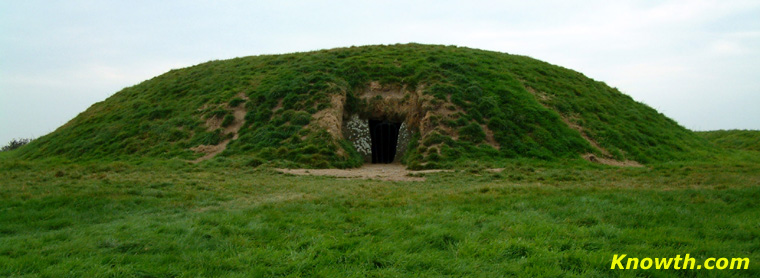Island of the Setting Sun
 Island of the Setting Sun - In Search of Ireland's Ancient Astronomers by Anthony Murphy and Richard Moore.
Island of the Setting Sun - In Search of Ireland's Ancient Astronomers by Anthony Murphy and Richard Moore.
Ireland is home to some of the world’s oldest astronomically-aligned structures, giant stone monuments erected over 5,000 years ago. Despite their apparent simplicity, these megalithic edifices were crafted by a scientifically knowledgeable community of farmers who endeavored to enshrine their beliefs in a stellar afterlife within the very fabric of their cleverly designed stone temples.
Finally back in print, this reissued edition presents evidence suggesting the builders of monuments such as Newgrange and its Boyne Valley counterparts were adept astronomers, cunning engineers and capable surveyors. Their huge monuments are memorials in stone and earth, commemorating their creators’ perceived unity with the cosmos and enshrining a belief system which resulted from a crossover between science and spirituality.
As investigation of this awe-inspiring civilization of people continues on many levels, evidence is emerging that significant archaeological sites dating from deep in prehistory are linked – not just through mythology, archaeology and cosmology – but through an arrangement of complex, and in some cases astonishing, alignments. Some of these alignments of ancient sites stretch from one side of Ireland to another.
While the accounts of the lives of some prominent Irish saints appear to be steeped in folklore and mystery, it seems from new interpretations of the literature that the cosmic world view which existed in Neolithic Ireland experienced a continuity right into the Early Christian period.
Purchase at Amazon.com or Amazon.co.uk
Archaeologists have been probing individual sites over the last fifty years, and have been revealing intriguing information, carvings, artefacts and dating material which, as well as answering many questions, pose even more about the purpose and genesis of these great monuments. Perhaps more importantly, some of the ancient stone sites continue to function more than five millennia after they were constructed, with famous examples, such as Newgrange and Dowth, featuring alignments to the winter solstice sun.
In Island of the Setting Sun a greater story of their genesis can finally be told. As these sites awaken from the slumber of five thousand years, we can more definitively describe their true purpose - to track time, vast periods of time, to bring the sky down on to the ground in a grand astronomical scheme. The authors' exploration of the sky-ground system is taken from an array of perspectives, most notably through the ancient stories about these places - some of which may be as ancient as the sites themselves. Within the complex layers of myth, folklore and place name stories lies a concealed astronomical language. Interpreting these coded cosmological messages, the authors have found that together the landscape, the astronomy and the myth reveal the true intent of the megalithic master builders of a time when giants were said to rule the land.
In this lavishly illustrated book, many disparate ideas and connections are explored, including the invasion myths of Ireland; the link between the ancient astronomers and St Patrick; the "pleasant plain" among the stars; the exciting rediscovery of "Ireland's Stonehenge"; the true inspiration behind Newgrange's white quartz facade; the many faces of the "sword-wielding giant" that is Orion; the migratory patterns of whooper swans; the female reproductive system and its importance to the mound-builders; the eight-year moon-Venus cycle; and a plethora of stories about such things as underwater spears, giant hounds, tragic drownings, cruel murders, vast battles, strange animals and the Irish cyclops. In short, Island of the Setting Sun provides a revision of how we look at prehistory in Ireland.
Island of the Setting Sun - Contents
Balor's Strand: Discoveries and BeginningsColpa: Invasion of the Milesians
Millmount: Burial Place of the Astronomer
Tara: Seat of the Sky King
Cosmic Circles: The Giant Rings
Dowth: The Darkening of the Sky
Newgrange: The Cygnus Enigma
Newgrange: Womb of the Moon
Knowth: Secrets of the Sky
Cosmic Grid: Lines Across the Land
Star Stories: Sky Myths of the Ancients
The High Man: Return of the King
Epilogue On the Brink
An article by Elaine Keogh in The Irish Times - 2 January 2007
 A new book
claims the megalithic tombs of the Boyne Valley were sophisticated and exact
calendars of celestial movement built by astronomers.
A new book
claims the megalithic tombs of the Boyne Valley were sophisticated and exact
calendars of celestial movement built by astronomers.
The authors of Island of the Setting Sun, Anthony Murphy and Richard Moore, assert that the stone age builders were influenced by Irish folklore and astronomy. Their theories are supported by astronomical data from the night sky of the time.
They believe the wall of white quartz on the exterior of Newgrange was probably inspired by the Milky Way.
"Five thousand years ago, the Milky Way would have been visible as a complete ring of light on the horizon at certain times of the year. This is something which does not happen now."
The authors believe Newgrange would have accepted light not only from the sun at the winter solstice but also from the moon and possibly Venus. These celestial bodies could also be behind the triple spirals cut into the entrance kerbstone.
They assert that the cross shape of the chamber at Newgrange and the smaller passage grave of Fourknocks some 15km (9.3 miles) away "echoes the cruciform outline of the swan constellation". The book reveals that the Newgrange passage points towards Fourknocks, and its chamber structure is orientated towards where Deneb - the brightest star in the constellation of Cygnus the swan - would have been rising about 5,000 years ago.
Newgrange is an important wintering ground for the whooper swan. In the Irish myth of Aonghus and Caer, the couple went "into" Newgrange after taking the form of swans.
"Our ancestors had developed a very complicated calendar based on sophisticated astronomical observations. They were able to predict eclipses of the moon."
Review printed in the Meath Chronicle - 23 December 2006
Hill of Tara - seat of the 'Sky King' according to a new book Island of the Setting Sun - In Search of Ireland's Ancient Astronomers, by Anthony Murphy and Richard Moore.The Hill of Tara is located at the centre of an extraordinary alignment of ancient sites and its location was probably chosen as part of a huge astronomical blueprint set down in the Stone Age, the authors of a new book have claimed. Island of the Setting Sun - In Search of Ireland's Ancient Astronomers, proposes a number of interesting new theories which suggest the ancient stone builders who inhabited Meath were advanced astronomers and surveyors who were able to arrange their sacred sites in straight lines across vast distances.
The authors, Anthony Murphy and Richard Moore, believe Tara's importance was accentuated by the fact that it lies between Carbury in Kildare, the place which mythology says was the rising point of the Boyne, and the Millmount in Drogheda, said to be the burial place of the Milesian astronomer poet, Amergin. "If you trace a line on a map from Millmount as far as Carbury in Kildare, it intersects Rath Maeve on Tara," said Anthony Murphy. "This is yet another example of the 'cosmic grid' of aligned ancient sites, and shows the level on which the ancient people worked. They were far more advanced than we give them credit for."
The Millmount-Tara alignment is even more fascinating because when one stands at the Hill of Tara on summer solstice, the longest day of the year, the sunrise comes up in the direction of Millmount. Conversely, when you're standing at Millmount on winter solstice, the shortest day, sunset lies in the direction of Tara. The pair believe that many of the ancient Irish myths and legends contain astronomical information, and propose that Tara was the "seat of the 'sky' king" because of the fact that the large man-like constellation of Orion, which may have been the inspiration for characters such as Nuadu / Nechtain, Cuchulainn and Fionn MacCumhaill, was setting over Tara viewed from Millmount in the Neolithic.
"Tara also sits on another unique alignment involving the hill of Realtoge (meaning star), the Hill of Slane and Mount Oriel in Louth. What we found looking at the story of St Patrick and the Paschal Fire was that King Laoghaire and his people would have been looking towards the rising of the cross-shaped constellation Cygnus at the moment when Patrick lit the fire on Slane" Mr Murphy added. The book proposes a number of interesting new theories about the Boyne Valley monuments. The authors claim to have found the true inspiration for the design of Newgrange, saying its chamber is based upon the Cygnus (swan) constellation, something that is supported by the mythology of Newgrange and its astronomical alignments. They believe they can explain why Newgrange is fronted by a wall of milky quartz also.
There is further intriguing information about how Dowth might have functioned as an astronomical observatory used in the study of eclipses, something which is supported by the mythology of Dowth which speaks of a sudden darkness in conjunction with summer solstice. In addition to all this, the authors put forward information about a possible solution to how the remarkable site of Knowth functioned as an astronomical device." What has become clear is that the astronomers who built the Boyne monuments used a complicated calendar based not only on the sun, but on the moon, planets and stars also" said Mr Murphy. Island of the Setting Sun - In Search of Ireland's Ancient Astronomers, is the product of eight years of research into the ancient astronomers. It runs to 330 pages and is printed in full colour with lavish illustrations, beautiful photography and remarkable paintings by the artist Richard Moore.
Boyne Valley Private Day Tour
 Immerse yourself in the rich heritage and culture of the Boyne Valley with our full-day private tours.
Visit Newgrange World Heritage site, explore the Hill of Slane, where Saint Patrick famously lit the Paschal fire.
Discover the Hill of Tara, the ancient seat of power for the High Kings of Ireland.
Book Now
Immerse yourself in the rich heritage and culture of the Boyne Valley with our full-day private tours.
Visit Newgrange World Heritage site, explore the Hill of Slane, where Saint Patrick famously lit the Paschal fire.
Discover the Hill of Tara, the ancient seat of power for the High Kings of Ireland.
Book Now
Home
| Newgrange
| Knowth
| Dowth
| Hill of Tara
| Fourknocks
| Loughcrew
| More Places
| Labyrinths
| Local Info
| Art Works
| Articles
| Images
| Books
| Links
| Boyne Valley Tours
| Contact

